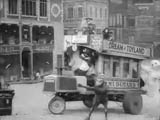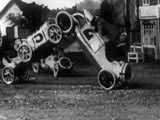

|
 | ALPHA TRADING COMPANY(1901-1915) |  |
||
|
Arthur Melbourne-Cooper worked for movie pioneer Birt Acres and was in at the birth of cinema. Initially shooting films for Acres, Cooper started to make and sell his own films. He experimented with stop-frame model animation ('stop-and-start' films as he called them), making some advertising films for Bryant & May featuring animated matchstick figures. In 1901, following the death of his father and the closure of Acre's company, the Northern Photographic Works, Cooper formed the Alpha Trading Company for the production of motion pictures. Closing down his Father's photographic business he invested his money in establishing the Alpha Cinematograph Works at Bedford Park in St Albans. The demand for films was increasing rapidly. Cooper produced live-action comedies and dramas, advertising films and newsreel items (or 'topicals' as they were called in the silent era), often employing freelance cameramen. He sold his films directly to the distribution companies and agents that had sprung up to exploit film sales, allowing him to concentrate on production. It would appear he dealt primarily with Robert Prieur, London sales agent for the French company Lux. Cooper also continued to make stop-motion films, producing roughly one a year. Many featured toys coming to life in dream sequences, from one doll in Dolly's Toys (1901) to the complex street scene in A Dream of Toyland (1907). Filmed in his spare time, using natural daylight, these crowd scenes could take weeks to complete, with friends and family roped in to move the various participants. The animated dream element from In the Land of Nod (1908) goes a step further, telling a sequential story in several scenes: a fire starts in a doll's house in Toyland and the fire brigade is summoned. Cooper's films sold well and the Alpha Cinematograph Works prospered. Cooper aquired the St Albans Polytechnic — a venue designed in 1903 as a social institute with four ground-floor reading/meeting rooms, a first-floor concert hall and a spacious basement intended for a gymnasium — to give public showings of his films. The shows were a big success and he decided to redevelop the building into a purpose-built cinema. The Alpha Picture House opened on 27 July 1908. Seating 800, with a sloping floor, cheaper seats at the front, electric illumination and the projection room separated from the auditorium, it was listed in the 1974 Shell Book of Firsts as one of the earliest examples of cinemas as they came to be. Cooper used the basement as a studio for his later stop-motion films, starting with Noah's Ark, in which a little girl dreams that her toy Ark and its contents act out the Biblical story. In July 1908 Cooper moved his studio from Bedford Park to his new home in Alma Road. The 2-acre property was almost as big as Bedford Park and had buildings suitable for housing the studio and laboratory. The house was suitable for raising a family — Cooper was married in February 1909. Emboldened by the success of the Alpha Picture House, Cooper opened a second one in December 1909, in Letchworth Garden City. This, however, proved to be a step too far. The citizens of Letchworth were largely disapproving of the movies, and business was not as good as Cooper expected. Two fires on the premises caused further expense. Because of the extreme flammability of early movie film, the risk of fire at public film shows was a serious issue. The Cinematograph Act 1909 specified a strict building code for places of commercial exhibition, with local authorities having the duty of inspecting and licencing all such venues. The Act came into effect on 1 January 1910. Cooper's cinemas failed the inspection, requiring more work in order to gain a licence. In a bid to protect the Alpha Trading Company and his personal liability Cooper formed a limited company, St. Albans Alpha Picture Palaces Ltd, to manage the cinemas. But it was too late: Cooper was finding it increasingly difficult to pay his bills. Cooper sold his interest and assets in the cinemas to the company in exchange for shares. These he gave to the directors of the distribution company Walturdaw in lieu of outstanding debts. They now held the controlling interest and George Dawson took over the management. By 1911 Cooper's debts were out of control. He was advised to declare bancrupcy but he determined to work his way out. He completed stop-motion productions The Cats' Football Match, Road Hogs in Toyland, in which toy cars cause havoc racing through the Toyland countryside, and Topsy's Dream of Toyland, a Christmas story in which (as far as I can deduce) a waif collapses in the snow and dreams a Fairy Prince makes her queen of the revels in Toyland where toys perform for her entertainment. She is rescued by a policeman and enjoys a real Christmas celebration. Cooper also continued making live-action films.. In early 1912 he joined forces with Andrew Heron, a retired Naval Officer keen to invest in film production, to form Heron Films Ltd, enabling him to draw an income. For Heron Films Cooper directed and shot a string of live-action comedies and documentaries, which were distributed by Universal Film Co. Frank Butcher, of W Butcher & Sons, had bought Road Hogs in Toyland and released it through his subsidiary company Empire Pictures in December 1911 for the holiday season. It had done well and Butcher now invited Cooper to come and make stop-frame films for Empire Pictures at his studio in Lee, near Blackheath, Kent. Cooper agreed, selling the Alma Road property, the last of the Alpha Trading Company's assets, to Butcher and moving into a house that backed onto Butcher's studio. Working through the summer and autumn he made three films for release over the Christmas holiday period. The contract with Butcher finished at the end of the year when Empire Pictures closed down. Cooper and Heron started a second company, Kinema Industries Ltd, "to take over the business of film manufacturers carried on as the Alpha Trading Company" as reported in the Bioscope on 6 March 1913. Kinema Industries Ltd and Heron Films shared an office at 4-5 Warwick Court, High Holborn. The basement became Cooper's laboratory and studio. By 1914, presumably having paid off the last of the Alpha Trading Company's debts, Cooper resumed using the Alpha name for his films. However, for chronological clarity I have listed the films made at Warwick Court under Kinema Industries. With the outbreak of the First World War in 1914, Andrew Heron was recalled to active service, and it was decided to close down his companies. When this was done, effectve in 1915, Cooper deregistered the Alpha Trading Company at the same time.
|
Filmography (animated or with animated segment) | ||||
| Cheese Mites | 1902 | |||
|---|---|---|---|---|
| Producer/Writer/Director/Animator: | Arthur Melbourne Cooper | |||
| Colour: | Black & White | |||
| Length: | 150 ft | |||
| A Boy's Dream | 1903 | |||
| Also known as: | The Miniature Circus; The Boy's Circus | |||
| Producer/Writer/Director/Animator: | Arthur Melbourne Cooper | |||
| Colour: | Black & White | |||
| Length: | approx. 200 ft | |||
| The Enchanted Toymaker | 1904 | |||
| Also known as: | The Fairy Godmother; Toy Maker and Good Fairy | |||
| Producer/Writer/Director/Animator: | Arthur Melbourne Cooper | |||
| Colour: | Black & White | |||
| Length: | 190 ft | |||
| Doings in Dolly Land | 1905 | |||
| Also known as: | Dolly's Doings | |||
| Producer/Writer/Director/Animator: | Arthur Melbourne Cooper | |||
| Colour: | Black & White | |||
| Length: | 375 ft | |||
| The Fairy Godmother | 1906 | |||
| Also known as: | The Little Fairy | |||
| Producer/Writer/Director/Animator: | Arthur Melbourne Cooper | |||
| Colour: | Black & White | |||
| Length: | 140 ft | |||
| Professor Bunkum's Performing Flea | 1907 | |||
| Also known as: | The Terrible Flea; The Wonderful Flea; That Awful Flea; The Showman's Treasure; Adventures of a Performing Flea; Wanderings of a Flea; A Phenomenal Flea; Flea Performing | |||
| Producer/Writer/Director/Animator: | Arthur Melbourne Cooper | |||
| Colour: | Black & White | |||
| Length: | 375 ft | |||
| A Dream of Toyland | 1907 | |||
| Producer/Writer/Director/Animator: | Arthur Melbourne Cooper | |||
| Assistants: | Stanley Collier, Herbert Cooper, Charles Raymond, Roger Pamphilon, Dr Dobbs and other friends and neighbours | |||
| Colour: | Black & White | |||
| Length: | 350 ft | |||
| In the Land of Nod | 1908 | |||
| Also known as: | Grandfather's Forty Winks; Father's Forty Winks; Grandpa's Forty Winks | |||
| Producer/Writer/Director/Animator: | Arthur Melbourne Cooper | |||
| Assistants: | Unknown | |||
| Colour: | Black & White | |||
| Length: | 365 ft | |||
| Magical Matches | 1908 | |||
| Also known as: | Mysterious Matches; Animated Matches; Magic Matches; A Box of Matches | |||
| Producer/Writer/Director/Animator: | Arthur Melbourne Cooper | |||
| Colour: | Black & White | |||
| Length: | 250 ft | |||
| Noah's Ark | 1909 | |||
| Also known as: | The Tale of the Ark; Lottie Dreams of her Noah's Ark | |||
| Producer/Writer/Director/Animator: | Arthur Melbourne Cooper | |||
| Assistants: | Unknown | |||
| Colour: | Black & White | |||
| Length: | 440 ft | |||
| The Toymaker's Dream | 1910 | |||
| Also known as: | The Old Toymaker's Dream; The Old Toymaker of Penny Town | |||
| Producer/Writer/Director/Animator: | Arthur Melbourne Cooper | |||
| Assistants: | Stanley Collier, Herbert Cooper, other staff members and the children of neighbours | |||
| Colour: | Black & White | |||
| Length: | 420 ft | |||
| Oxford Street Up-to-Date | 1910 (Possibly a reissue of A Dream of Toyland) | |||
| Producer/Writer/Director/Animator: | Arthur Melbourne Cooper | |||
| Colour: | Black & White | |||
| Length: | 350 ft | |||
| The Cats' Cup Final | 1911 | |||
| Also known as: | The Cats' Football Match | |||
| Producer/Writer/Director/Animator: | Arthur Melbourne Cooper | |||
| Assistants: | Stanley Collier, Herbert Cooper, other staff members | |||
| Colour: | Black & White | |||
| Length: | 360 ft | |||
| Topsy's Dream | 1911 | |||
| Also known as: | Topsy's Dream of Toyland | |||
| Producer/Writer/Director/Animator: | Arthur Melbourne Cooper | |||
| Assistants: | Unknown | |||
| Colour: | Black & White | |||
| Length: | 350 ft | |||
| Road Hogs in Toyland | 1911 | |||
| Producer/Writer/Director/Animator: | Arthur Melbourne Cooper | |||
| Assistants: | Unknown | |||
| Colour: | Black & White | |||
| Length: | 330 ft | |||
Links to Other Sites | ||||
Arthur Melbourne-Cooper pioneer film maker: East Anglian Film Archive - sample films, mainly live-action but includes A Dream of Toyland | ||||
Google Books - 'They Thought it was a Marvel': extracts from the highly recommended book by Tjitte de Vries and Ati Mul | ||||
Academia - 'Survival of the Fittest': BBK Masters Research Paper by Dr Josephine F. Coleman examining the development of the Picture Palace, including a detailed study of the Alpha Picture Palaces. |
Peter Hale
Last updated 2020
|